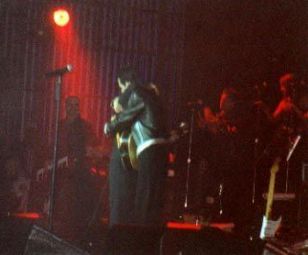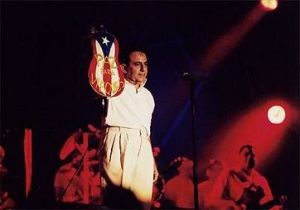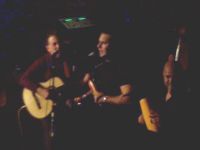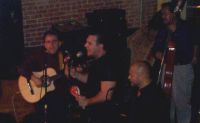 Revista
Domingo, The New Day, Puerto Rico
Revista
Domingo, The New Day, Puerto RicoAugust 27th, 2000 by Bibiana Ferraiuoli Su?rez
English Translation by Crystal Gonzalez, NY, NY
Photos Luis Vidal
 Revista
Domingo, The New Day, Puerto Rico
Revista
Domingo, The New Day, Puerto Rico
August 27th, 2000 by Bibiana Ferraiuoli Su?rez
English Translation by Crystal Gonzalez, NY, NY
Photos Luis Vidal
Dialogue on tres
The sound of the Tres of Nelson Gonz?lez knows no limits. He is perhaps one of the best Tres players in the world today-if not the best.
The sun is shining. It?s a good day to think about the rehearsal of the band that?s waiting to play for Marc Anthony, in his concert Marc Anthony Live. The group is anxiously and nervously waiting in the Hiram Bithorn stadium. In English and Spanish they are complaining about the heat that envelops them.Rolex Replica But when it comes to playing, they are the ones that send out the heat.

The brief moment, mixed with peace, fear an emotion, ends when his musicians play the first chords of Preciosa, and he says to them, ?my hair is standing on end.? A little bit after he starts singing, his potent voice fuses with the sounds of the band and creates magic.
 He has repeatedly said, that to have Nelson Gonz?lez play for him is ?an
honor.? The musician smiled with a certain timidness at the surprise of the
hug, and then greeted and hugged another friend, Danny Rivera.
He has repeatedly said, that to have Nelson Gonz?lez play for him is ?an
honor.? The musician smiled with a certain timidness at the surprise of the
hug, and then greeted and hugged another friend, Danny Rivera.
In Marc, there doesn?t just live a great singer, but more so a sincere friend.
He says that they met during the play ?The Capeman? through Paul Simon.
?He asked me if I would like to play in his band, so here I am.? He explains
that although Marc?s music is Pop, and Nelson plays a traditional instrument,
the mix is perfect. ?He is the director of the Orchestra and he transmits to
us energies with his voice, and some force brings together the sounds of each
instrument.? He follows by saying, ?The Tres is not as traditional as it
seems. The music they play in the band isn?t new for me. For the most part it
expands the range, because I don?t like to put limits on an instrument.? He
reminisced back to the ?70?s to remember when, in that decade, his group
Tipica 73, ?completely revolutionized the music of latins and Americans, jazz,
and the blues.? He believed in an explosive fusion. ?I was the baby of the
group: I couldn?t say much, but I stayed with them to try a little rock, to
change the sound of the traditional Tres. I considered the Tres my electric
guitar. Jimmy Hendrix included me when he wrote the history of the music,? he
comments. Typically, most guitarists reflect the image of the
volatile performer with adrenaline at maximum. As for Nelson, who moved here to
New York when he was in the sixth grade, he also likes tranquility. ?I don?t
look for opportunities for fame because fame doesn?t interest me.
I like to travel frequently to Puerto Rico and lose myself in Vega Baja
with my family.? During his quiet time, he immerses himself in the worlds of
Gabriel Garc?a M?rquez, with the works of Mario Vargas Llosa, and with the
verses of Pablo Neruda. ?Oh, how I like the poetry.? He says while hugging
his Tres.

(In the recent Marc Anthony concert the band was an essential part. In the Hiram Bithorn stadium, Nelson Gonz?lez delivered the message of Vieques by painting on the back side of his Tres.)
Puerto Rican Treseros are something rare in the world of
music, because the famous instrument has it?s roots in Cuba. According to the
dictionary of Cuban music by Helio Orovio, ?since 1982, a ledgendary famous
person like Nen? Manfug?s played the Tres in the streets of Santiago, Cuba,
that he brought from Baracoa.? Derived from the guitar, the Tres consists of
three pairs of strings: Two in high octaves and the third in a low octave. It is
always identified as a typical Cuban instrument. Nelson began playing at 13
years of age in a Pentacostal church in New York. Once, the famous musicians of
Cachao?s band told him he had to be Cuban. He disagreed with pride, ?No, I
am Puerto Rican like the Coqui.? Although he began as a guitarist, the exposed
nature of the Tres, as well as the difficulty, drew him to the Tres. ?In the
Tres the three pairs of strings are separated. The edge is distinct. The Tres
doesn?t allow you to do things like you can with a Cuatro or a guitar. For me
it is a challenge, because it is not easy to have a rhythmic sensibility outside
of the norm.? he admits. Nelson takes his commitment to the instrument very
seriously. ?In Puerto Rico, like in other countries, the customs are in danger
of extinction, and they are traditions that we cannot afford to lose.? In an
effort to promote the instrument, Nelson gives lessons to ten students of
diverse Hispanic American nationalities. Nelson is currently writing an
instruction manual for th e Tres for the Mel Bay guitar book series.
e Tres for the Mel Bay guitar book series.
Those who know Nelson only have good things to say about
him. His son Joseph spent the day admiring the musical talent at the Hiram
Bithorn stadium. Himself a promising folkloric singer and dancer, he will also
dance at the Hiram Bithorn stadium. At the end of the year, father and son will
make a record together. Revista
Domingo knows that in his free time, Nelson colaborates with SER de Puerto Ricon, los Centros Sor Isolina
Ferr? and other causes. In recent months, he asked his friend, Cuban
actor Andy Garcia to make a video for the kids of SER, and the actor did without complaint.
Nelson is easily as talented as the artists he has worked with. Some of his more notable collaborations were with Madonna and Gloria Estefan. He has also played with Jay Leno?s band three times on the show, and performed on ?Saturday Night Live.? These celebrities recognize his talent, and his special way with a melody on his Tres.
To converse with Nelson is also a great privilege. It?s
like taking a music history class in a few hours, because the conversation will
always return to New York in the ?70?s, when the orchestras of Ray Baretto,
Tipica ?73, and Fania All-Stars were creating our modern Salsa styles. The
story starts back even furthe r, to his blessed beginnings, when he chose this
rarely played instrument, and continues to his adolescence during the glory days
of salsa. His first big break came at 18 with the Orchestra of Justo Betancourt.
He also played a few popular sessions in a club called ?and Vinny?s,?
among others in the New York area. But his greatest influence was the Afro Cuban
music. ?It?s that the music included everything. Also, the importance and
implementation of the Tres called to me. It is vital because it functions like a
piano in the rhythm section. How could I not fall in love? So I began to collect
music of this genre. All that I found I bought and afterwards I experimented.?
From those sessions, he began to find his musical voice, and the offers poured
in from different nightclubs in Queens. ?Through Cachao?s band, I made
connections with Lino Fr?as of the Sonora Matancera, the Orchestra Revelaci?n
of Ismael Miranda, Willie Colon, Oscar Hern?ndes: Director of Son Del Solar,
Ray Barretto, Tipica 73, Nicky Marerro,
and the Fania All-Stars. The offers seemed to come out of nowhere.?
r, to his blessed beginnings, when he chose this
rarely played instrument, and continues to his adolescence during the glory days
of salsa. His first big break came at 18 with the Orchestra of Justo Betancourt.
He also played a few popular sessions in a club called ?and Vinny?s,?
among others in the New York area. But his greatest influence was the Afro Cuban
music. ?It?s that the music included everything. Also, the importance and
implementation of the Tres called to me. It is vital because it functions like a
piano in the rhythm section. How could I not fall in love? So I began to collect
music of this genre. All that I found I bought and afterwards I experimented.?
From those sessions, he began to find his musical voice, and the offers poured
in from different nightclubs in Queens. ?Through Cachao?s band, I made
connections with Lino Fr?as of the Sonora Matancera, the Orchestra Revelaci?n
of Ismael Miranda, Willie Colon, Oscar Hern?ndes: Director of Son Del Solar,
Ray Barretto, Tipica 73, Nicky Marerro,
and the Fania All-Stars. The offers seemed to come out of nowhere.?
When we asked Nelson if he remembered the following excerpt,
he couldn?t do anything but laugh, remembering the long music sessions:
| ?There is an orchestra, gentlemen, that has a total sound. |  |
| They dream to play, dream to come together. | |
| They dream sensational dreams. | |
| They begin with a rumba, salsa, or guajira or bemb?. | |
| Listen to the new sound of Tipica 73." |
Back to start page